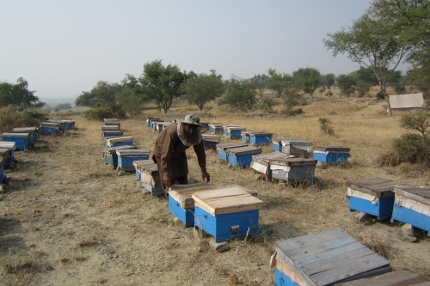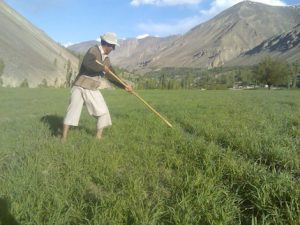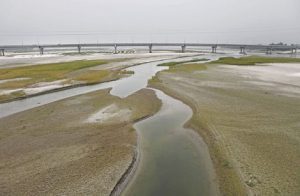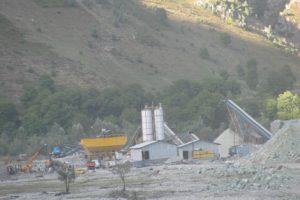Beekeeping is helping farmers in Pakistan cope with crop failures as a result of erratic weather patterns and irregular rainfall
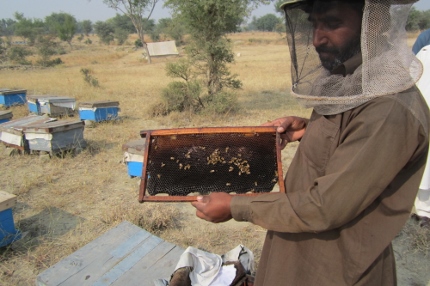
Battered by erratic weather patterns with decreasing and delayed rainfall, thousands of farmers in Pakistan’s northeast Potohar plateau are moving to beekeeping as an alternative source of livelihood that is less vulnerable to climate change.
A single flood, no or deficient rain in one cropping season, or lack of water in the river system due to delayed glacial melt can ruin farmers’ livelihoods. “However, training farmers in alternative climate-resilient livelihoods like beekeeping can go a long way in making farming communities resilient to climate change impacts,” said Dr. Zafar Iqbal, former chairperson of the National Disaster Management Authority, in Pakistan’s capital Islamabad.
The fact that many farmers find beekeeping a more profitable alternative and therefore reduce farming or completely shun it has its own impact on food security. But it helped many households survive in Potohar – a sprawling region between the Indus and the Jhelum rivers and stretching up to the foothills of the Himalayas. Around 70% of rain in the region is received between July and August.
“Because of erratic weather patterns and unreliable crop harvests, our income had become irregular and was declining. But the beehives give us regular income,” said Hakim Khan, a beekeeper in Ghool village of Chakwal district, about 90 kilometres southeast of Islamabad.
The district — one of the four in Potohar along with Attock, Rawalpindi and Jhelum – is known for its exportable quality of groundnuts and stretches over 6,500 square kilometres of semi-arid terrain. It has a population of nearly 1.5 million and relies entirely on the rains for cultivation of crops.
It was known as an area for abundant rain. However, the situation has changed over the years. Until 1998, it would receive around 1,200 millometres rainfall annually. This has come down to less than 900 millometres, according to the Pakistan Meteorological Department.
Groundnut and wheat farmer Jehan Khan in Ghool village is one of those who have suffered. His groundnut output came down 60% and the wheat crop dipped by 30% last year. “Last year, per acre yield of the groundnut crop was less than 200 kilogrammes. There was 70% less rain during the sowing season March-April,” he said.
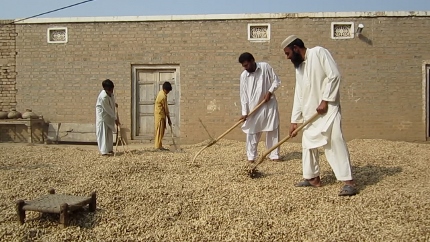
“A target of 70,000 acres was set for last year’s groundnut sowing season. But hardly 50% of the target could be achieved in August because of the short rain spell,” Mohammad Khalid, Chakwal district agriculture officer, told thethirpole.net.
“For wheat, rains were needed in November and December last year. But it rained in late December, that too in patches,” he said, adding that the wheat crop was likely to be 30% less this year.
In this scenario, beekeeping has been a saviour for many families in the area. Hakim Khan from Ghool, for instance, survived the poor harvest by taking to beekeeping. He also continues to grow groundnut.
“The additional income from beekeeping has helped me survive crop losses. I adopted beekeeping three years ago to cover up income losses from the groundnut crop,” Khan said while examining the wooden bee boxes on a plot adjacent to his groundnut field.
He was amongst the lucky ones trained in beekeeping — producing honey, hives and wax — by the Pakistan Poverty Alleviation Fund (PPAF) under the Drought Mitigation and Preparedness Project. Farmers in various villages of Chakwal district have also been provided with financial aid.
In a ripple effect, Khan has taught other farmers about beekeeping and its benefits. “I learnt about the economic benefits of less labour and investment (in beekeeping)… Now, more and more farmers are approaching to me to learn about beekeeping,” he told thethirdpole.net.
Citing an example, he said a groundnut farmer-turned-beekeeper who purchased 10 wooden boxes of hives for Pakistani Rs.34,000 (about US$347) three years ago now has 90 boxes worth Pakistani Rs.1,020,000 (about US$10,400).
“Alternative livelihood plans like beekeeping can definitely help farming communities adapt to shifting weather patterns and mitigate the negative impacts on their socio-economic lives,” said Raja Munir Hussain Janjua, regional programme officer at the National Rural Support Programme.
The list of alternatives, he added, included animal husbandry and cattle rearing as well as skills such as mobile phone repairing. Plans are also afoot for training people for trades such as tailoring and embroidery and then to help provide market access for their products.
The effort, Zafar Pervez Sabri, senior climate change mitigation and adaptation expert at PPAF, told thethirdpole.net, was also to ensure that farmers continue growing crops even if income drops due to drought.
This would help avoid food insecurity issues, he said.
About 1,150 farmers in Chakwal had been trained in beekeeping, many of whom had already shown visible improvement in lifestyle.
“Having seen tangible socio-economic impacts on the lives of farming communities in drought-prone Chakwal district, we have planned to expand these alternative livelihood plans to different parts of Pakistan, particularly Bhawalpur and Tharparkar districts. Crop failures are common phenomena in these rain-fed areas too,” he said.
Bee numbers dwindle with climate change
Agronomist and former member of Pakistan Prime Minister’s Task Force on Climate Change Pervaiz Amir said completely abandoning farming and shifting to beekeeping was not a good idea and not viable either.
“After all, bees need also crops to pollinate and make beeswax… bees need crops, flowers, trees and fruits for collecting pollen to make beeswax,” Amir said. “We should, however, combine beekeeping with diversified crop production.”
Under its Honeybee Programme, the Honeybee Research Institute (HBRI) of the Pakistan Agriculture Research Council in Islamabad has so far introduced bee farming all across Pakistan and trained as many as 9,000 people, including women, in the beekeeping business.
Of the 100 crop species that provide 90% of the world’s food, over 70 are pollinated by bees, according to the UNEP study.
The business of bees — essential to pollinate crops, fruits and vegetables such as cotton, sunflower, carrot, cabbage and apple — itself is under threat. According to HBRI senior scientific officer Ghulam Sarwar, though there is no indication that bees are declining in the country, there is the possibility that bee colonies are in danger from global warming.
“Some species of bees could face extinction while their declining numbers could harm the harvest of crops such as apples,” he said.
According to Inter-Government Panel on Climate Change (IPCC) reports, climate change, after land-use changes, could be deemed the second most relevant factor responsible for the pollinators’ decline.
“Climate change is a juggernaut and we are not going to be able to slow it down in the next 10 or 20 years, so we need to do something much more quickly: providing good quality habitats for bees and trying to reduce other pressures on them such as habitat loss and the impact of pesticides,” Amir said.
